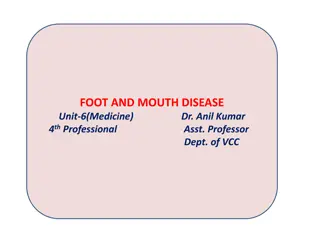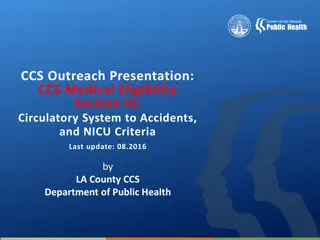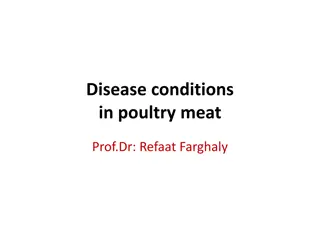Understanding Steatotic Liver Disease: Importance, Epidemiology, and Pathology
Steatotic liver disease, including metabolic dysfunction associated steatohepatitis (MASLD) and metabolic associated alcoholic liver disease (MALD), is a common cause of liver test abnormalities in the United States. Risk factors such as obesity and metabolic syndrome can lead to advanced fibrosis a
2 views • 44 slides
Innovations in Infectious Disease Control: Insights from Experts
Explore the latest advancements in infectious disease control through the lens of renowned epidemiologists and researchers. Delve into the impact of the COVID-19 pandemic, the historical prevalence of infectious diseases, and early infection prevention practices. Uncover the evolution of infectious
0 views • 22 slides
Understanding the Natural History of Disease Development and Prevention
The natural history of disease development outlines the progression of a disease in an individual without intervention, from exposure to outcome. Learning objectives include defining prevention terms, understanding disease severity, prevention levels, and intervention measures. Studying disease prog
4 views • 16 slides
Best Neurosurgery Hospitals in India
Neuro diseases are very bad diseases. Many people are caught by Neuro diseases nowadays. It is related to brain diseases. Many people in India are caught by Neuro Diseases. It happens in Adults as well as children.\nA person of any age can be affected by this. Before this time very bad disease Named
1 views • 2 slides
Principles of Epidemiology: Understanding Disease Occurrence and Surveillance
Epidemiology is the study of disease patterns, factors influencing disease occurrence, and the core functions of surveillance, field investigation, and analytic studies. It involves understanding disease characteristics, natural history, and evaluating the effectiveness of activities to mitigate dis
1 views • 25 slides
Understanding Social Determinants of Health
Chronic conditions like heart disease and cancer have multiple causes, not all biological. Social epidemiology studies the social distribution of health, morbidity, and mortality risk influenced by social status and conditions. Factors such as age, gender, race, socioeconomic status, and social cond
0 views • 32 slides
Heart Health Jeopardy - Test Your Knowledge on Heart Disease
Test your knowledge on heart disease with this Heart Health Jeopardy game. Learn about heart disease facts, statistics, risk factors, and common types of heart diseases. Understand the importance of recognizing heart attack symptoms and the significance of factors like high blood pressure, high chol
0 views • 58 slides
Insights into Tyzzer's Disease: An Overview of a Bacterial Infection in Laboratory Animals
Tyzzer's disease is an acute bacterial infection affecting rodents and rabbits, caused by Clostridium piliforme. Discovered in 1917 by Ernest Tyzzer, the disease is characterized by necrotic lesions in the caecal mucosa, liver, and heart. Initially known as Bacillus piliformis, it was later renamed
2 views • 21 slides
Importance of Screening and Separation in Marburg Virus Disease Control
Early identification and separation of suspected Marburg virus disease patients play a crucial role in preventing the spread of the disease within healthcare settings. Screening and setting up specific areas for identification and isolation are essential steps to protect healthcare workers, patients
1 views • 15 slides
Foot and Mouth Disease: Overview, Symptoms, and Sequelae
Foot and Mouth Disease, also known as Aphthous fever, is a highly contagious viral infection affecting cloven-hoofed animals. It is characterized by the formation of vesicles and erosions in the mouth, nose, teats, and feet. The disease can cause a fall in milk yield, high fever, loss of appetite, a
1 views • 8 slides
Understanding Disease Control and Prevention in Epidemiology
This article discusses disease control processes in epidemiology, including reducing disease incidence, duration, and transmission. It covers public policy interventions, elimination, eradication, and extinction of infectious agents. It also highlights preventable causes of disease and different lev
2 views • 10 slides
Understanding Co-occurring Mental and Physical Health Conditions
Co-occurring mental and physical health disorders are prevalent and require an integrative multidisciplinary approach for effective assessment and treatment. This holistic approach helps address the complexity of managing multiple disorders in an integrated healthcare setting. Through a multi-direct
1 views • 37 slides
Understanding Parkinson's Disease: Diving Deeper into the Neurodegenerative Disorder
Parkinson's disease is a neurodegenerative disorder that impacts dopamine levels in the brain. The history, epidemiology, causes, and pathophysiology of the disease are explored, shedding light on its significant impact on the nervous system. Genetic and environmental factors play a role in the deve
0 views • 25 slides
Dealing with Disease in Early Modern Britain
Explore the methods of treating disease in Early Modern Britain, including advancements in surgery by Ambroise Pare and Andreas Vesalius, the prevalence of quackery in medicine sales, and the impact of individuals like Lady Johanna St. John and Nicholas Culpeper. Evaluate the effectiveness of diseas
0 views • 8 slides
Understanding Trypanosomiases: African Sleeping Sickness and Chagas Disease
Trypanosomiases are parasitic diseases caused by Trypanosoma parasites, with African sleeping sickness and Chagas disease being the two main types affecting humans. African sleeping sickness, transmitted by the tsetse fly, can lead to chronic or acute illness and is primarily found in Africa. The di
0 views • 13 slides
Screening for Peripheral Vascular Disease in Patients with Coronary Artery Disease
Patients with coronary artery disease should be screened for peripheral vascular disease as it is a frequent integrator of global cardiovascular risk. The association of atherosclerosis in various arterial diseases highlights the importance of identifying multisite artery disease. The prevalence and
0 views • 23 slides
Understanding the Impact of Nutrition on Periodontal Disease
Periodontal disease, like caries, is multifactorial and influenced by the balance between bacterial challenge and host defense. Nutritional factors play a subtle but significant role in maintaining periodontal health. A deficiency in nutrients can adversely affect the periodontal tissues and modify
0 views • 23 slides
Understanding Akabane Disease: Causes, Symptoms, and Prevention
Akabane disease, also known as Enzootic Bovine Arthrogryposis and Hydranencephaly, is a viral illness transmitted by arthropods that primarily affects calves, lambs, and kids. The disease can lead to congenital abnormalities such as joint immobility and absence of the cerebral hemisphere. It is caus
2 views • 19 slides
Human Disease Symptom Network: Understanding Disease Relationships Through Symptoms and Genes
The Human Disease Symptom Network (HSDN) is constructed using a large-scale medical bibliographic records database to form a network of human diseases based on symptom similarities. By integrating disease-gene associations and protein-protein interaction data, correlations between symptom similarity
0 views • 37 slides
Medical Eligibility Criteria for Circulatory and Respiratory Diseases in CCS Outreach Presentation
This presentation outlines the medical eligibility criteria for circulatory and respiratory diseases under the California Children's Services (CCS) program. It covers conditions such as diseases of the circulatory system including endocardium, myocardium, and more, as well as respiratory conditions
0 views • 38 slides
Understanding Aquatic Epidemiology in Fish Populations
Aquatic epidemiology is a crucial branch of science that focuses on describing the health, diseases, and welfare of fish populations. It involves studying diseases in wild and hatchery-raised fish, identifying factors influencing disease occurrence, and conducting diagnostic investigations to mainta
0 views • 12 slides
Understanding Plant Pathology: Reproduction and Classification of Bacteria
This course on Fundamentals of Plant Pathology, led by Mr. Vikash Kumar, covers essential topics such as disease identification, pathogen nature, disease management strategies, pathogen classification, and plant disease diagnosis. It delves into the reproduction and classification of plant pathogeni
0 views • 16 slides
Understanding Descriptive Epidemiology in Public Health
Descriptive epidemiology involves the study of disease occurrence and distribution in populations. It focuses on describing patterns of disease occurrence based on who gets sick, where rates are highest and lowest, and temporal patterns of disease. Descriptive studies are essential for public health
0 views • 18 slides
Understanding Bacterial Diseases of Fish: Columnaris Disease Overview
Columnaris disease, also known as Saddleback disease, is a common bacterial infection in fish that is often brought about by poor handling and high stress levels. This disease manifests as tail and fin rot, leading to rapid fish mortality. The causative organism, Cytophaga (formerly Flexibacter), is
0 views • 21 slides
Pharmacotherapy Overview of Parkinson's Disease and Related Disorders
Overview of pharmacological treatment options for Parkinson's disease and related conditions like choreatic dyskinesias, spastic disorders, and myasthenia gravis. Describes the degenerative process of Parkinson's disease, its symptoms, and the pharmacological interventions targeting dopamine deficit
0 views • 26 slides
Understanding Foot-and-Mouth Disease (FMD) and Bovine Viral Diarrhea (BVD)
Foot-and-mouth disease (FMD) is a highly contagious animal disease affecting cloven-hoofed animals, while Bovine Viral Diarrhea (BVD) is a serious cattle disease caused by the BVD virus. FMD is not transmissible to humans and is caused by different strains of Aphthovirus. Symptoms of FMD include ves
0 views • 12 slides
Understanding Disease Frequency and Impact Measures
This informational resource delves into various aspects of disease frequency, effect measures, and impact, covering key terms like exposure and disease. It also discusses important measures like incidence rate, prevalence rate, and risk difference. Examination questions related to the incidence and
0 views • 16 slides
Managing Communicable Disease Reporting in Childcare Facilities
Michigan law requires schools and childcare centers to report specific diseases promptly to the local health department. Reporting helps identify disease trends, outbreaks, and epidemics, enables preventative measures, aids in resource allocation, and supports disease surveillance efforts. Guideline
0 views • 18 slides
Understanding Coeliac Disease and Modified Diets for a Healthier Lifestyle
Coeliac disease is an autoimmune condition that affects the body's ability to process gluten, leading to various symptoms like abdominal pain, fatigue, and nutrient deficiencies. Following a modified diet, such as a vegetarian or gluten-free diet, can help manage these symptoms and promote better he
0 views • 17 slides
Decoding Genetics: Insights from Alzheimer's Disease Symposium to Type 2 Diabetes Study
Explore the latest findings from the Alzheimer's Disease Genetics Symposium 2019 on disease mechanisms, drug targets, and genetic pathways. Dive into the progress made by the Alzheimer's Disease Genetics Consortium over the past decade. Transition to a Genome-Wide Association Study uncovering suscep
0 views • 42 slides
Liver Disease Burden in Tower Hamlets
Dr. Somen Banerjee, Director of Public Health in London Borough Tower Hamlets, highlights the concerning liver disease mortality rates in the area, with high incidence of cirrhosis, cancer, and hepatitis B and C. The data reveals a significant burden of liver diseases such as Non-Alcoholic Fatty Liv
0 views • 18 slides
Understanding Kidney Injury and Liver Disease in the ICU
This presentation delves into the intricacies of acute kidney injury (AKI) and its occurrence in patients with liver disease in the intensive care unit (ICU). It covers the definitions, classifications, and causes of AKI, emphasizing the Hepatorenal Syndrome, a form of functional renal failure in en
0 views • 29 slides
Understanding Inflammatory Bowel Disease: Crohn's Disease and Ulcerative Colitis
Inflammatory Bowel Disease (IBD) encompasses Crohn's disease (CD) and ulcerative colitis (UC), chronic conditions with immunologic basis. This article delves into the epidemiology, pathophysiology, and differences between CD and UC, highlighting clinical features, pathology, and complications like a
0 views • 42 slides
Understanding Heart Disease: Causes, Symptoms, and Common Conditions
Heart disease, a prevalent health issue in the United States, encompasses various cardiovascular conditions like coronary artery disease and hypertension. It is a leading cause of death, often resulting from conditions that can lead to heart attacks or failure. Symptoms of heart conditions vary, fro
0 views • 28 slides
Ultrastructural Alterations of Renal Tissue in a Male Patient with Fabry's Disease
Fabry's disease is a rare X-linked lipid storage disorder characterized by deficient lysosomal alpha-galactosidase A activity. This condition primarily affects males, leading to chronic kidney disease and progression to end-stage renal disease. Kidney involvement is a critical aspect, and high doses
0 views • 24 slides
Argentina Alzheimer's Disease Neuroimaging Initiative Overview
The Argentina Alzheimer's Disease Neuroimaging Initiative (arg-ADNI) is a comprehensive program focusing on the early detection and characterization of Alzheimer's disease (AD) and related conditions. The initiative involves inviting and following patients through various stages, including baseline
0 views • 5 slides
Disease Conditions in Poultry Meat: Causes, Symptoms, and Lesions
This detailed information by Prof. Dr. Refaat Farghaly discusses various disease conditions in poultry meat, including bacterial, viral, parasitic, and protozoal diseases. It covers diseases such as tuberculosis, fowl cholera, marek's disease, salmonellosis, and coccidiosis, providing insights into
0 views • 28 slides
Understanding Viral Pathogenesis: Causes and Consequences
Viral pathogenesis involves the process by which a virus leads to disease, exploring the interplay between viral and host factors. It encompasses the concepts of virulence, viral disease, and the effects on infected cells and the host's immune response. Changes within infected cells, including cell
0 views • 26 slides
Climate Change and Health Impacts on People with Medical Conditions
Climate change poses significant risks to the health of individuals with existing medical conditions, making them more vulnerable to illnesses and adverse health effects. Common chronic medical conditions such as heart disease, diabetes, asthma, COPD, Alzheimer's disease, and mental illness can exac
0 views • 8 slides
Overview of Heart Disease and Statistics in the UK
Heart disease and circulatory conditions are major causes of death in the UK, with statistics showing high mortality rates in both men and women. The data reveals trends in death rates, particularly from coronary heart disease (CHD), across different demographics and time periods. Despite some decli
0 views • 39 slides







































